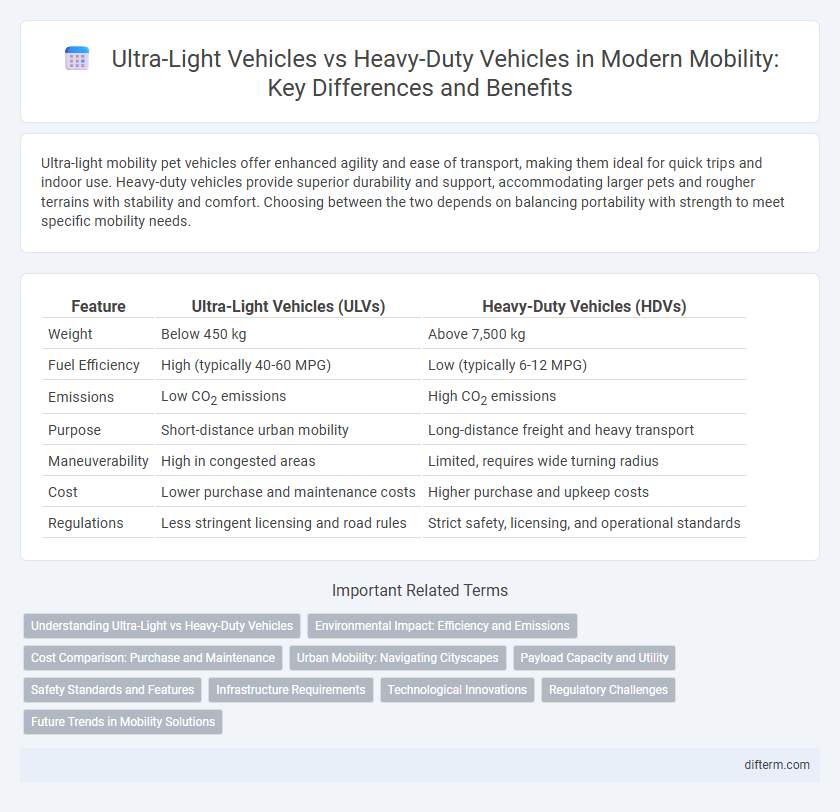Ultra-light mobility pet vehicles offer enhanced agility and ease of transport, making them ideal for quick trips and indoor use. Heavy-duty vehicles provide superior durability and support, accommodating larger pets and rougher terrains with stability and comfort. Choosing between the two depends on balancing portability with strength to meet specific mobility needs.
Table of Comparison
| Feature | Ultra-Light Vehicles (ULVs) | Heavy-Duty Vehicles (HDVs) |
|---|---|---|
| Weight | Below 450 kg | Above 7,500 kg |
| Fuel Efficiency | High (typically 40-60 MPG) | Low (typically 6-12 MPG) |
| Emissions | Low CO2 emissions | High CO2 emissions |
| Purpose | Short-distance urban mobility | Long-distance freight and heavy transport |
| Maneuverability | High in congested areas | Limited, requires wide turning radius |
| Cost | Lower purchase and maintenance costs | Higher purchase and upkeep costs |
| Regulations | Less stringent licensing and road rules | Strict safety, licensing, and operational standards |
Understanding Ultra-Light vs Heavy-Duty Vehicles
Ultra-light vehicles, designed with minimal weight under 1,000 kg, offer enhanced energy efficiency and agility ideal for urban mobility and short-distance travel. Heavy-duty vehicles, often exceeding 7,500 kg, prioritize durability and load capacity for industrial applications, long-haul transport, and construction tasks. Understanding these distinctions is crucial for optimizing transport solutions based on use case, fuel consumption, and environmental impact.
Environmental Impact: Efficiency and Emissions
Ultra-light vehicles provide significant environmental benefits through higher energy efficiency and lower emissions compared to heavy-duty vehicles, consuming less fuel and producing fewer greenhouse gases per mile traveled. Their reduced weight minimizes road wear and decreases the demand for energy-intensive manufacturing materials, contributing to a smaller carbon footprint. In contrast, heavy-duty vehicles generate greater emissions due to larger engines and fuel consumption, leading to increased environmental impact and stricter regulatory challenges.
Cost Comparison: Purchase and Maintenance
Ultra-light vehicles generally have a lower purchase price compared to heavy-duty vehicles, making them more accessible for individual consumers and small businesses. Maintenance costs for ultra-light vehicles are significantly reduced due to simpler mechanics, lower fuel consumption, and less frequent part replacements. Heavy-duty vehicles, while more expensive to buy and maintain, are designed for durability and high-capacity tasks, often justifying the higher costs in commercial and industrial applications.
Urban Mobility: Navigating Cityscapes
Ultra-light vehicles enhance urban mobility by offering greater maneuverability and reduced congestion in cityscapes compared to heavy-duty vehicles, which often struggle with narrow streets and dense traffic. Their compact size and energy efficiency contribute to lower emissions and easier parking solutions, addressing critical urban challenges. Prioritizing ultra-light vehicles supports sustainable transportation infrastructure and improves overall traffic flow in metropolitan areas.
Payload Capacity and Utility
Ultra-light vehicles offer enhanced maneuverability and fuel efficiency but typically have limited payload capacity, making them ideal for small-scale urban deliveries and personal transport. Heavy-duty vehicles boast significantly higher payload capacities, supporting large-scale freight transport and industrial applications, though they often consume more fuel and require robust infrastructure. Balancing utility with operational requirements, choosing between ultra-light and heavy-duty vehicles depends on the specific payload demands and logistical scalability within the mobility ecosystem.
Safety Standards and Features
Ultra-light vehicles comply with emerging safety standards designed to protect occupants despite their reduced mass and size, often featuring reinforced frames, advanced occupant restraint systems, and pedestrian detection sensors. Heavy-duty vehicles adhere to rigorous, well-established safety regulations, incorporating robust crash structures, advanced braking systems, and electronic stability control to mitigate risks during high-impact collisions. Safety features in both vehicle categories continue to evolve, driven by innovations in sensor technology, real-time monitoring, and autonomous emergency intervention systems.
Infrastructure Requirements
Ultra-light vehicles demand significantly less infrastructure support due to their reduced weight and smaller size, enabling the use of narrower lanes and lighter pavement materials. Heavy-duty vehicles require reinforced roads, larger turning radii, and more robust bridges to accommodate their increased mass and dimensions. Efficient urban planning integrates both vehicle types by optimizing dedicated lanes for ultra-light vehicles while ensuring heavy-duty routes maintain structural integrity for commercial transport.
Technological Innovations
Ultra-light vehicles leverage advanced materials like carbon fiber composites and lightweight alloys to enhance fuel efficiency and reduce emissions in urban mobility. Heavy-duty vehicles incorporate cutting-edge technologies such as hybrid powertrains, autonomous driving systems, and telematics to optimize performance and safety in freight transport. Both vehicle categories benefit from innovations in electric propulsion and energy recovery systems that drive the transition toward sustainable transportation.
Regulatory Challenges
Ultra-light vehicles face significant regulatory challenges due to inconsistent classification standards across regions, impacting safety requirements and road access permissions. Heavy-duty vehicles are subject to stringent emissions and safety regulations, increasing compliance costs and operational constraints for manufacturers and operators. Harmonizing regulatory frameworks is essential to facilitate innovation and integration of both ultra-light and heavy-duty vehicles into existing mobility ecosystems.
Future Trends in Mobility Solutions
Ultra-light vehicles are gaining traction in future mobility solutions due to their energy efficiency, reduced environmental impact, and suitability for urban logistics and last-mile delivery. Heavy-duty vehicles are evolving with advanced electrification and hydrogen fuel technologies to meet stringent emissions regulations while maintaining high load capacity and operational range. Integration of smart connectivity and autonomous driving systems is transforming both ultra-light and heavy-duty vehicles into more sustainable and efficient transport options.
ultra-light vehicles vs heavy-duty vehicles Infographic

 difterm.com
difterm.com